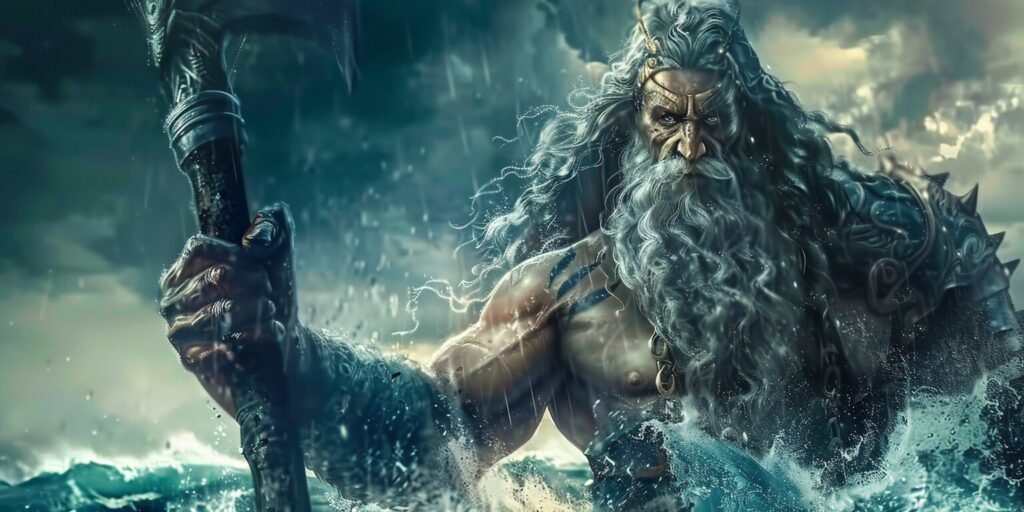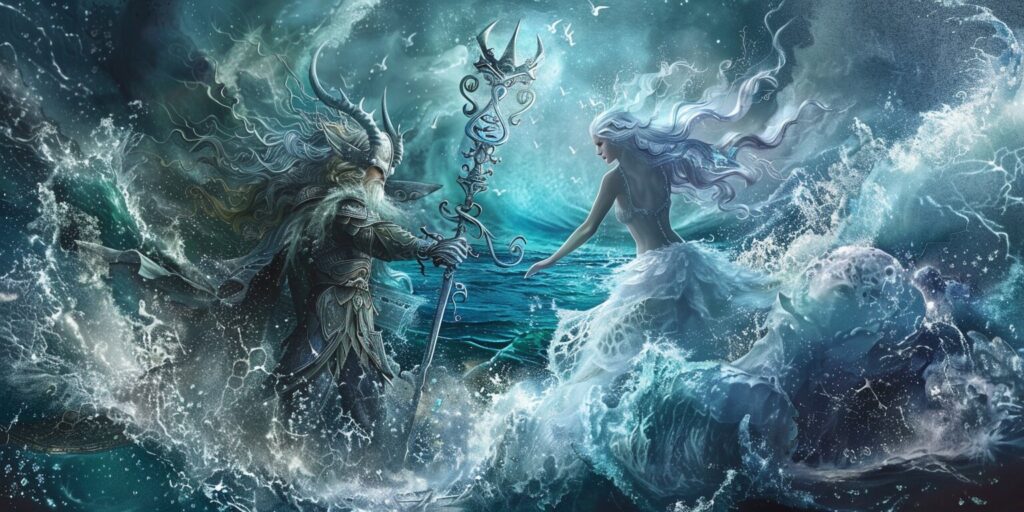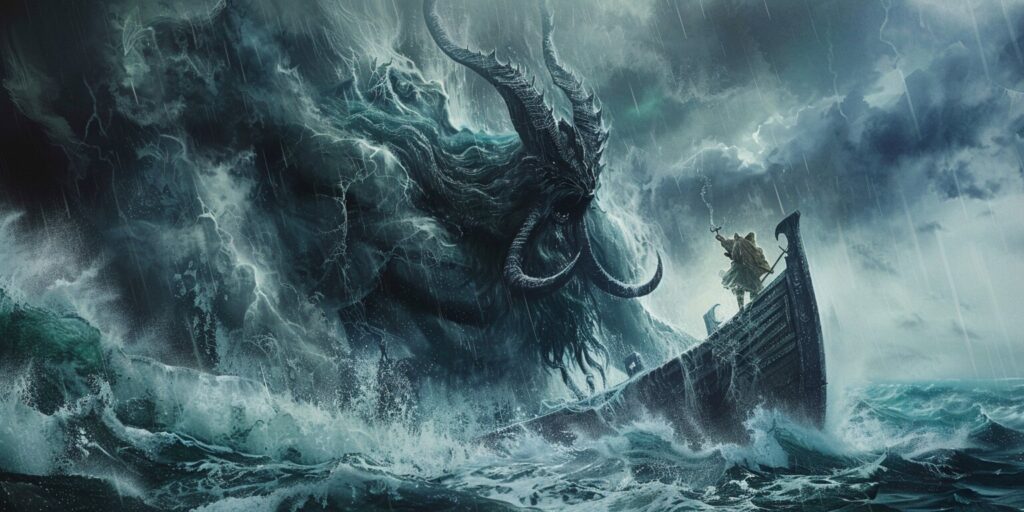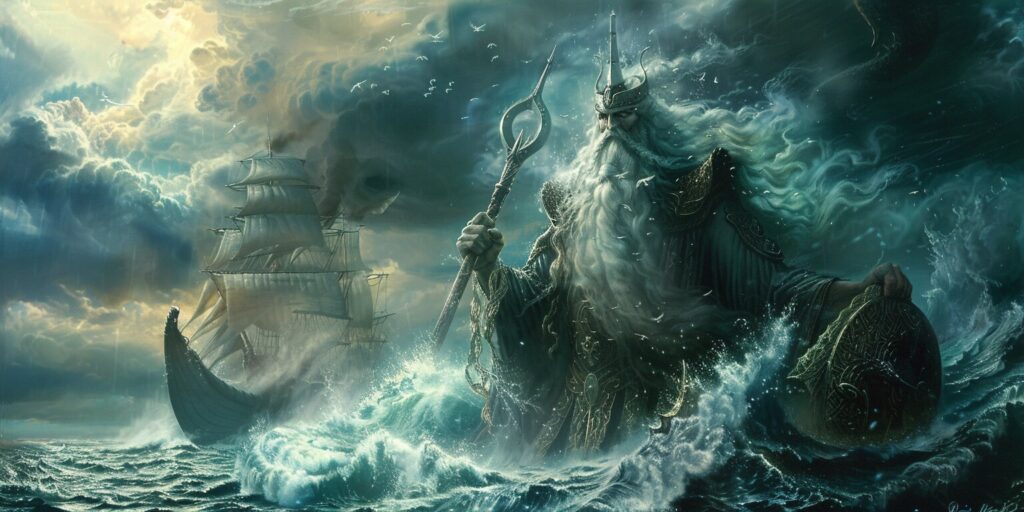Norse Gods, Norse Mythology, Tales of the Gods
Who Is The Norse God Of The Ocean?
Welcome to our exploration of the fascinating world of Norse mythology! In this article, we will delve into the realm of the Viking Ocean god, also known as the Norse ocean god. Mythology played an integral role in the rich tapestry of Viking culture, providing a framework for understanding the mysteries of the natural world and the divine forces that governed it.
At the heart of this mythology lies a pantheon of gods and goddesses, each with their own domain and significance. Among them, the Viking ocean god reigns supreme as the ruler of the sea, commanding the depths and wielding power over the turbulent waters. So, keep reading our article to determine who the Norse god of the ocean is.
Norse Mythology: A World of Gods and Goddesses
Welcome to the captivating realm of Norse mythology, where a pantheon of gods and goddesses reigns supreme in the hearts and minds of the Vikings. This ancient belief system is steeped in mythology and folklore, offering a fascinating glimpse into the rich tapestry of Norse culture. Among the many deities revered by the Vikings, one figure stands out – the viking goddess of the sea.
In Norse mythology, the viking goddess of the sea holds a prominent place. Known for her power and influence over the vast ocean, the seafaring Vikings revered and feared her. Worshiped by sailors and explorers alike, this goddess embodies the strength and mystery of the sea, commanding their respect and devotion.
As you dive deeper into the realms of Norse mythology, prepare to encounter a multitude of gods and goddesses, each with their unique stories and powers. From the mighty Thor, the god of thunder, to the cunning Loki, the trickster, the pantheon of Norse deities paints a vivid picture of a world where gods and humans coexist, their fates and destinies intricately intertwined.
An Intricate Web of Divine Beings
The gods and goddesses in Norse mythology possess distinct domains and attributes, reflecting their individual roles and responsibilities. From Odin, the chief of the gods, to Freya, the goddess of love and war, this intricate web of divine beings explores the various facets of life and nature that the Vikings revered.
As you explore these mythological tales, be prepared to encounter fierce warriors, formidable giants, and enigmatic creatures that inhabit the realms of Norse mythology. From the mythical land of Asgard, home to the gods, to the mysterious world of the giants known as Jotunheim, the realms within Norse mythology offer vast landscapes filled with adventure and wonder.
The Mighty Aegir: Ruler of the Sea
In Norse mythology, Aegir holds the esteemed title of being the Viking god of the ocean. Known for his immense power and authority, Aegir is revered as the ruler of the sea and all its depths. As a deity of great significance in Viking culture, he commands respect and admiration from both gods and mortals.
Aegir possesses distinctive characteristics that set him apart in the pantheon of Norse deities. With his striking and commanding presence, he exudes authority and control over the vast expanse of the ocean.
Among the many gods and goddesses of Norse mythology, Aegir holds a prominent position. While he may not be as well-known as some of the more widely recognized deities, his importance cannot be understated. Aegir’s dominion over the sea is paramount in the Viking cosmology, with the ocean playing a crucial role in their culture and way of life.
Aegir’s role as the Viking god of the ocean extends beyond mere rulership. He also deeply understands the sea’s mysteries and untamed forces. As such, sailors and seafarers often invoke him to safeguard their voyages and ensure their safe return. His authority extends to the ocean’s creatures, making him an influential figure in maritime affairs.
Aegir stands out as a formidable presence when exploring Norse mythology and its gods. His association with the ocean and his position as the ruler of its vast depths cement his place as a powerful and influential deity within Viking culture.
Aegir’s Domain: The Depths of the Ocean
In Norse mythology, the ocean holds immense significance and is seen as a powerful force that shapes the world. At the heart of this vast expanse of water is Aegir, the viking god of the ocean and ruler of its depths.
Aegir’s domain stretches across the vast expanse of the sea, encompassing its depths and hidden treasures. It is a mysterious and dangerous realm where countless creatures reside, and powerful forces are at play.

The ocean is a source of life and sustenance, providing the Vikings with valuable resources and opportunities for exploration and trade. It was believed that Aegir controlled the currents, tides, and storms that shaped the oceans, possessing the power to calm or unleash their fury.
To the Norse people, Aegir’s domain represented both awe-inspiring beauty and unforgiving chaos. The sea was revered as a powerful force, and its unpredictable nature was attributed to Aegir’s influence. The Vikings held great respect for the viking ocean god and sought his favor to ensure safe voyages and bountiful catches.
The Treasures of the Deep
Within Aegir’s domain lie countless treasures that capture the imagination of seafarers and adventurers. According to Norse mythology, Aegir held magnificent feasts in his underwater hall, where he entertained both gods and giants. These feasts were said to be grand events, with the ocean god providing abundant food and drink from the depths of the sea.
Aegir’s association with abundance and prosperity further solidifies his importance in Viking culture. The ocean was a source of physical sustenance and a spiritual connection to the divine. The Vikings saw Aegir’s domain as a gateway to the realms beyond, where gods and mythical beings resided.
Adventures and Perils
Viking mythology is teeming with tales of adventurers who braved the perils of the ocean in search of glory and riches. These stories often revolve around encounters with Aegir or creatures of the deep.
Aegir’s domain is home to creatures like the giant sea serpent Jormungandr, whose mere presence causes the seas to churn and tempests to arise. Here, battles between gods and giants took place, and heroes embarked on their quests to prove their worth.
Exploring Aegir’s domain meant facing not only the physical challenges of the sea but also the wrath of the Viking ocean god himself. As the ruler of the ocean’s depths, Aegir wielded great power and commanded respect.
In conclusion, Aegir’s domain represents the vast and mysterious depths of the ocean in Norse mythology. It is a realm of beauty, danger, and opportunity — a domain that captivates the imagination and leaves a lasting impression on Viking culture and beliefs.
Aegir’s Family: The Oceanic Pantheon
In Norse mythology, Aegir, known as the Viking god of the ocean, is not alone in his divine rule over the vast seas. He belongs to a family of mighty deities within the oceanic pantheon. Let’s explore the relationships between Aegir and his fellow gods and goddesses, delving into the rich tapestry of myths and legends that surround them.
Aegir and Ran: Rulers of the Sea
Aegir is often depicted as the husband of Ran, the Viking goddess of the sea. Together, they hold dominion over the oceans, controlling its tides and currents. In Norse mythology, Ran is associated with drowning and the collection of souls lost at sea, serving as a counterpart to Aegir’s role as a benevolent provider of abundance and prosperity.

The Daughters of Aegir
Aegir and Ran are said to have nine daughters, known as the Aegirsdottir or the waves of the sea. These beautiful and powerful sea goddesses are often portrayed as mermaids or half-human, half-fish creatures. Each daughter represents a different aspect of the ocean, from calm waters to treacherous storms. They are revered as protectors of sailors and bestowers of fortune.
- Nine daughters: Noatun (the wave), Gandvik (enclosure of the waves), Blóðughadda (bloody hair), Bylgja (billow), Dröfn (the foamy one), Dúfa (the dove), Hefring (rising wave), Himinglæva (transparent-at-the-good). Sægreip (sea-grip).
Aegir’s Mysterious Kinship
While Aegir’s immediate family is well-known, his exact lineage within the oceanic pantheon remains a mystery. Some speculate that he is related to the powerful god Njord, who rules over the winds and the sea. Others believe he may be connected to the legendary Jotunn, a race of giants often associated with the forces of nature. The true origins of Aegir add an air of mystique to his character and highlight the complexities of the Norse deities.
Join us in the next section as we unravel Aegir’s captivating legends and tales, delving deeper into the myths surrounding this viking ocean god.
Legends of Aegir: Norse Myths and Stories
In the captivating world of Norse mythology, Aegir, the viking ocean god, stands tall as a figure of power and intrigue. His tales are woven with encounters and rivalries, showcasing his influence over the vast expanse of the sea. One notable legend tells of Aegir’s encounter with the mischievous Loki, where their interactions test the boundaries of their power and wit.
Among the myths that highlight Aegir’s dominion over the ocean, the tale of his grand feast for the gods stands out. This extraordinary event, known as the “Aegir’s Feast,” brought together the deities in a magnificent gathering to celebrate the bounty of the sea. Aegir’s ability to provide an abundance of food and drink from the depths of the ocean showcases his role as the patron of seafarers and fishermen.
Another fascinating legend portrays Aegir’s role in Ragnarok, the Norse apocalypse. As the ancient prophecies foretold, Aegir’s tempestuous nature unleashes chaos upon the world during this cataclysmic event. With his fierce storms and crashing waves, Aegir symbolizes the destructive power of the sea and its pivotal role in shaping the destiny of the gods and mortals alike.
The Treasures of the Deep
- Aegir’s legendary cauldron of mead, known as the “Aegir’s Brew,” is said to have the power to grant immortality to those who partake in its elixir.
- In Norse folklore, brave heroes are said to sail into the ocean to retrieve Aegir’s lost treasures, venturing into the abyss to seek fortune and glory.
- Aegir’s underwater hall, known as “Hlesey,” is believed to be a breathtaking palace beneath the waves where the viking ocean god resides in awe-inspiring splendor.
As these myths and legends entwine, they paint a vivid picture of Aegir’s influence on the Norse pantheon and their collective belief in the power of the ocean. From his tumultuous encounters with other gods to his involvement in pivotal events, Aegir’s presence resonates throughout the rich tapestry of Norse mythology, solidifying his status as a legendary viking ocean god.
Worship and Rituals: Honoring the Viking Ocean God
In Norse mythology, Aegir is revered as the Viking god of the ocean, also known as the Norse ocean god. The Vikings revered Aegir greatly and sought to honor him through various worship practices and rituals. These ceremonies and offerings were carried out with the belief that they would gain his favor and protection.
One of the primary ways the Vikings worshipped Aegir was through grand feasts and celebrations. These gatherings, known as “Aegir’s feasts,” were held to honor the god and express gratitude for the bountiful harvests and successful voyages provided by the sea.
Offerings to Aegir
The Vikings offered him gifts and sacrifices to appease Aegir and ensure his continued blessings. These offerings typically included valuable items such as jewelry, weapons, and precious metals. They were cast into the sea as a symbol of devotion and respect.
It was believed that Aegir resided at the bottom of the ocean in his splendid hall, where he hosted magnificent feasts for the gods and honored guests. To capture Aegir’s attention and gain his favor, the Vikings presented him with food and drink offerings. They crafted intricate drinking horns and filled them with mead, a fermented beverage highly cherished by the Norse people.
Ritual Ceremonies in Aegir’s Honor
In addition to feasts and offerings, the Vikings performed ritual ceremonies dedicated to Aegir. These ceremonies were held at designated locations near the sea or on ships, symbolizing the realm of Aegir.
- The Vikings would gather at these sacred sites and engage in prayers and invocations, calling upon Aegir to protect their voyages and ensure safe passage.
- During these ceremonies, the Vikings would also enact storytelling rituals, recounting tales of Aegir’s mighty power, his role in shaping the seas, and his interactions with other gods and mythical creatures.
- Music and poetry were integral to these ceremonies, with Viking skalds composing elaborate verses praising Aegir and the wonders of the ocean.
- Dancing and singing were also common during these rituals, as the Vikings believed that lively festivities pleased the viking god of the ocean, eliciting his favor and benevolence.
Through their worship and rituals, the Vikings demonstrated their deep respect and awe for Aegir, the viking god of the ocean. They believed that by honoring him, they could secure his protection, ensure successful sea voyages, and harvest the abundance of the sea. The legacy of Aegir’s worship and rituals remains an important aspect of Viking culture, showcasing the significance of the Norse ocean god in the lives of the Norse people.
Symbols and Depiction: Visualizing Aegir
When it comes to Aegir, the viking ocean god, symbolism played a crucial role in his depiction. In Norse art, Aegir was often represented as a powerful figure who embodied the might and vastness of the ocean. Artists depicted him with flowing hair and a full beard, symbolizing his wisdom and age. His eyes were often portrayed as deep and all-knowing, reflecting his ability to peer into the depths of the ocean.
One of the prominent symbols associated with Aegir was the cauldron, which represented the abundance and life-giving properties of the sea. The cauldron was often adorned with intricate engravings and patterns, symbolizing the intricate and unpredictable nature of the ocean. It served as a reminder of Aegir’s role in providing sustenance and riches through the bounty of the sea.
Imagery and Visual Themes
A recurring visual theme in Aegir’s depiction was the presence of sea creatures and marine life. The artwork would often feature fish, whales, and other creatures swimming around him, illustrating his close connection and dominion over the oceanic realm. These depictions aimed to convey Aegir’s ability to harness the power of the sea and its inhabitants.
Aegir was also often shown alongside his wife, Ran, a viking goddess associated with the sea and underwater currents. The imagery of Aegir and Ran together further emphasized their combined influence over the ocean and their role in shaping its tides and currents.
The Importance of Symbolism
Symbols played a vital role in Norse art and mythology, and they provided a visual language through which the Vikings communicated their beliefs and stories. The symbols associated with Aegir served as a reminder of the power and significance of the ocean in Viking culture and highlighted Aegir’s role as the viking ocean god.
- The cauldron represented abundance and the life-giving properties of the sea.
- Sea creatures symbolized Aegir’s dominion over the oceanic realm.
- The presence of Ran emphasized the combined influence of Aegir and his wife over the sea.
These symbols and visual themes allowed the Vikings to connect with and honor Aegir, reminding them of his role as a powerful deity and the importance of the ocean in their lives.
Aegir’s Legacy: Impact on Viking Culture
Throughout Viking culture, the viking ocean god Aegir left a lasting legacy that influenced various aspects of society.
1. Maritime Activities
Aegir’s role as the Viking god of the ocean solidified his influence over maritime pursuits. Vikings, known for their seafaring prowess, revered Aegir and sought his protection and guidance when venturing across treacherous waters. His worship played a significant role in shaping the development of Viking shipbuilding techniques and navigation skills, enabling the Norse people to become formidable sailors.

2. Beliefs and Rituals
Aegir’s mythology permeated Viking beliefs, shaping their understanding of the ocean and its mysteries. His worshippers believed that Aegir controlled the tides, waves, and storms, and they performed rituals to appease him in hopes of favorable conditions for their voyages. Aegir’s presence in Viking folklore instilled a sense of awe and respect for the mighty forces of the ocean, influencing the spiritual connection between the Norse people and the vast seas they navigated.
3. Cultural Symbolism
Aegir’s depiction in Viking art and literature served as a powerful cultural symbol. His image, often portrayed with a long beard and a commanding presence, represented strength, power, and the untamed forces of nature. Aegir’s mythological tales and legends served as a source of inspiration for poets and storytellers, preserving his legacy within Viking cultural heritage.
4. Influence on Norse Festivals
Aegir’s influence extended to Norse festivals, particularly those associated with the sea and seafaring. The Viking’s celebration of summer solstice, known as Midsummer, involved rituals and offerings to Aegir, ensuring safe travels and bountiful catches for fishermen. These festivals served as a reminder of the god’s importance, reinforcing his role in the daily lives of the Viking community.
Aegir, the Norse ocean god, left an indelible mark on Viking culture, shaping their maritime activities, beliefs, symbolism, and festivals. His legacy continues to resonate, reminding us of the profound impact mythology can have on a civilization.
Conclusion
Throughout this article, we have explored the fascinating world of Norse mythology and the viking god of the ocean, Aegir. As a viking ocean god, Aegir holds immense significance in Viking culture and mythology. His domain, the ocean’s vast depths, symbolizes power and mystery.
Aegir, the Norse ocean god, is known for his role as the ruler of the sea, controlling its tides and waves. He is a prominent figure within the oceanic pantheon of Norse gods and goddesses, and his family connections offer invaluable insights into the complexities of the Viking deities.
Legends and stories surrounding Aegir further illustrate his power and influence. From his encounters with mythical beings to his involvement in major events, Aegir’s mythology is both captivating and deeply rooted in Norse tradition.
The impact of Aegir on Viking culture cannot be understated. His worship, rituals, and mythology shaped the maritime activities and beliefs of the Vikings. Aegir, the viking god of the ocean, remains an enduring symbol of the Vikings’ deep connection to the sea and their reverence for the forces of nature.

